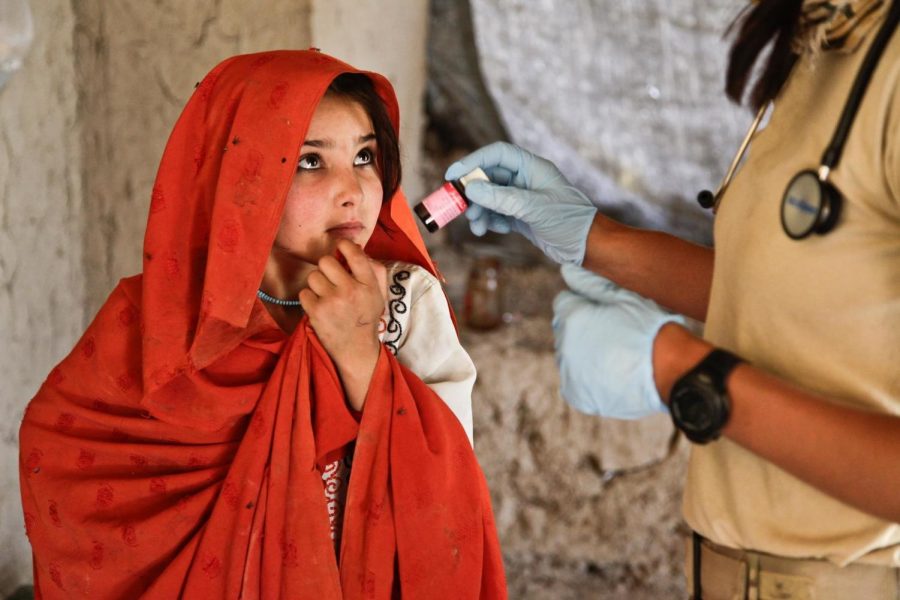Healthcare and Legacy of Gender Apartheid in Afghanistan
The fight for gender inequality in Afghanistan is an ongoing battle. But the Taliban takeover created several hurdles for women, especially in the healthcare sector.

As the Taliban steadily gains more control over the country, fear and turmoil permeate the lives of Afghani women. Though the Taliban pledged to respect women’s rights, many recent reports from Human Rights Watch, CNN, and CNBC suggest otherwise. So, inside a socio-economic fabric embedded with misogyny, Afghani women are more vulnerable now.
While Afghanistan grapples with human rights and free speech violations, it must also confront the abuse of women’s bodily autonomy and the collapsing healthcare system of the country that cannot provide sufficient information about health and family planning. The current instability due to Covid-19 contributed to the critical shortage of healthcare workers. And so, the percentages of period poverty, infant mortality, and postpartum depression are soaring to double digits.
Period poverty refers to the inadequate access to information and services necessary for menstrual health. Period poverty is so severe in Afghanistan that it is declared a public health crisis. Driven by stigma and poor sanitary conditions, period poverty breeds emotional and psychological issues in women. According to the National Library of Medicine, impacts of menstrual poverty ranges from anxiety, seclusion, depression, and general discontentment.
The absence of adequate mental health facilities in Afghanistan means that its population lives with untreated mental illnesses. Moreover, a study done by Emily Henderson, B.Sc. concluded that deprivation from proper menstrual sanitation makes women more vulnerable to depression. “Among our sample, 14.2% of women had experienced period poverty ever in the past-year; an additional 10% experienced it every month. Compared to those who had never experienced period poverty, adjusted analysis revealed that women with monthly past-year period poverty were the most likely to report moderate/severe depression,” the study posits. Similarly, Human Rights Watch also released a report highlighting the silent mental health epidemic in Afghanistan and its obvious connection to Taliban rule: “Afghanistan has been devastated by violence, and it is estimated that half the population experiences depression, anxiety, or post-traumatic stress, which can have a disastrous impact on people’s mental health and the well-being of their relatives and friends. Despite this, the government only spends about US$0.26 per capita on mental health, out of $7 spent annually per capita on health services in general.”
Apart from period poverty, there is also a rise in infant mortality and postpartum depression. With the United States evacuating people from Afghanistan, the socialization to a new culture will likely increase postpartum (PDD) depression. An NCBI study analyzed the influx of PDD present in migrant women due to cross-cultural challenges. And with high wealth inequality, infant mortality, and maternal mortality, PDD becomes more common. Social, political, economic factors lead to drastic differences in the prevalence of PDD between two countries.
Currently, Afghanistan has the highest maternal mortality rate. According to the UN, approximately six hundred and thirty-eight women die per hundred thousand live births. And infant mortality rate is fifty-six deaths per thousand births. Additionally, World Bank observed a widening wealth inequality in Afghanistan wherein the richest 20% saw a 9% increase in expenditure meanwhile the poorest 20% saw a 2% decline.
Now that foreign aid for Afghanistan is frozen due to the Taliban’s takeover, the economic hardships will worsen over time. Healthcare cutbacks, of course, come at the expense of the public struggling to cope with political upheaval.
The hospitals also experienced significant cutbacks because they are heavily reliant on foreign aid. Over 75% of Afghanistan’s budget is foreign aid. According to a doctor from Kapisa, a province in northeast Kabul, “Women and girls struggle to get even the most basic information about health and family planning. There is an unmet need for modern forms of contraception, and prenatal and postnatal care is often unavailable. Cancer and fertility treatment and mental health care are largely unavailable. Routine preventive care such as pap smears and mammograms are almost unheard of, and a large proportion of births are still unattended by a professional.
Women often have more children than they want because of lack of access to modern contraception; face risky pregnancies because of lack of care, and undergo procedures that could be done more safely with more modern techniques. Maternal and infant mortality remain very high.”
And with 550,000 people from Afghanistan displaced so far, the likelihood of a refugee health crisis increases. According to the CDC, 73% of Afghani women show signs of depression, 83% live with anxiety, and 48% have symptoms of PTSD.
So, with 16,000 people evacuating Afghanistan, significant cross-cultural and language barriers will lead to misdiagnosis of mental illnesses. “Given the unique mental health challenges refugee women face, it is hypothesized that the interplay between culture and postpartum depression amongst refugee women may differ from other migrant women.” And, “The studies identified through this scoping review provide a rich description of the significant impact culture has on the conceptualization and experience of postpartum depression among refugee women resettled in high-income countries,” a study noted.
Through resilience and courage, people in Afghanistan navigate these tumultuous times. Gender equity gap in healthcare has a long history of oppression and stigma. Supporting refugees seeking asylum requires the development of specialized institutes and researchers capable of exploring the unique impact of war on women.
For that, we need to provide financial aid to healthcare centres in Afghanistan that are crumbling under the weight of war. To understand the complicated roots of gendered violence in Afghanistan, we should also provide platforms to Afghani women journalists, writers, and poets.







